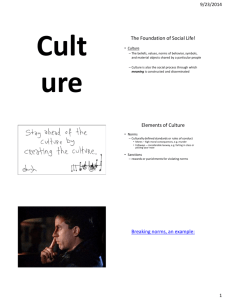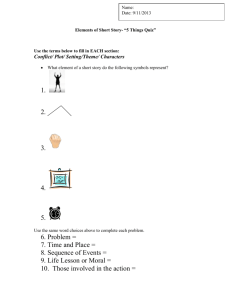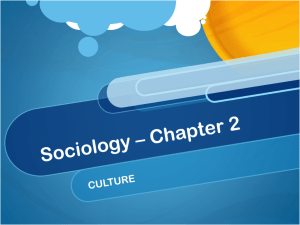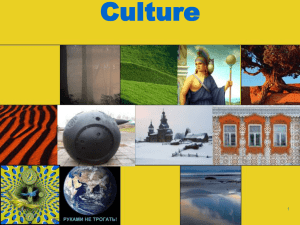B. What is Culture? - Prof. Kurt Reymers
advertisement
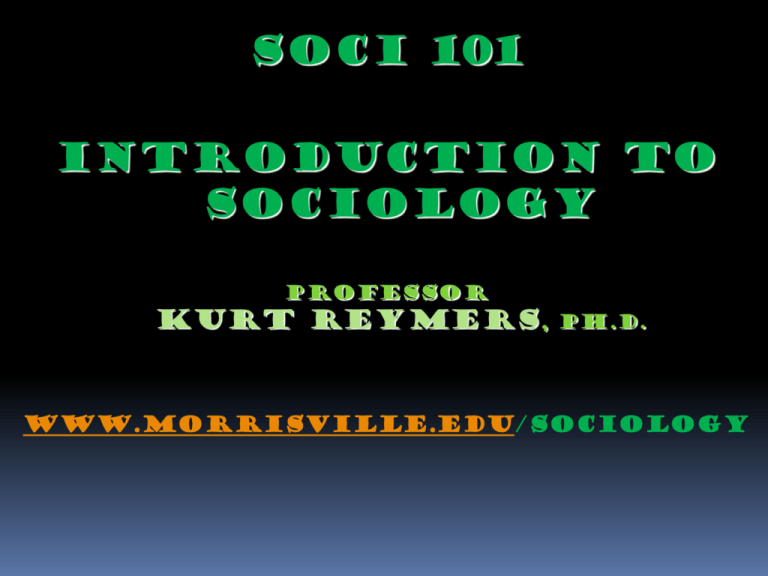
SOCI 101 Introduction to Sociology Professor Kurt Reymers, Ph.D. WWW.morrisville.edu/SOCIOLOGY Theme: Global Culture Artist: Mamadou Diabate Region: Kenya (East Africa) Song: Dagna Album: Tunga (2000) Theme: Global Culture Artist: Prem Joshua Song: Bo lo Hari Album: Dance of Shakti Theme: Language and Symbols Artist: Sheila Chandra Song: Speaking in Tongues III Album: Zen Kiss B. What is Culture? 1. Culture refers to the symbols, values, behavior and material objects (artifacts) that together form a people’s way of life. a. Sociologists point out that “Culture is to people like water is to fish.” In other words, we take our cultural inheritance for granted. It seems natural to us – but it is not. Ethnocentric: centered on one’s own ethnicity (or culture), to the point where you cannot judge another culture on their own terms. Culture Shock: the disorientation experienced when confronted with a new set of norms and values B. What is Culture? 2. How can we better understand the idea of culture? Culture is BOTH: ACTION a. Material culture – tangible, physical cultural artifacts. Example: paper money b. Non-material culture – intangible, mental cultural meanings. Example: value of a “dollar” THOUGHT It is through CULTURE that thought and action come together. B. What is Culture? 3. Components of Culture There are four main components to culture: a. Symbols b. Language c. Values, Beliefs and Norms d. Artifacts B. What is Culture? a. Symbols A symbol is anything that carries a particular meaning recognized by people who share a culture. Each of our social institutions is populated with a vast number of symbols which hold specific meaning to us. Examples: economic institutions = $ € £ ¥ religious institutions = political institutions = language = people = w w ت C. Components of Culture b. Language and Communication A system of symbols that allows people to communicate with one another. i. Origins: 3500 BC, Mesopotamia Written language developed with civilization. ii. Purpose: Cultural transmission Language passes on cultural ideas. How? SELF culture /language SOCIETY How do people learn language (or any other cultural trait)? Appropriation and Replication C. Components of Culture c. Values, Norms and Beliefs i. Values are culturally defined standards of desirability, goodness, and beauty, which serve as guidelines for social living. In an open society, values are always being debated. Variation exists in the meaning of values; these differences can lead to “Culture Wars.” ii. Norms = ideals for social behavior “Folkways”: everyday conventions (saying “good afternoon”) “Mores”: deeper ideals (virtue, justice – more strictly enforced) iii. Beliefs are statements that people hold to be true. Does Belief = Truth? How do we KNOW what to BELIEVE? C. Components of Culture c. Values, Norms and Beliefs Ways of knowing: 1) Observation (“empirical evidence”) SCIENCE PERCEPTION : : : : : : : : : : : : : : : : : : : : BELIEF (I see a chair. I believe it exists.) 2) Reason / Logic (“rationality”) PRINCIPLE : : : : : : : : : : : : : : : : : : : : BELIEF (2+2 = 4) 3) Intuition / Faith RELIGION PERSUASION : : : : : : : : : : : : : : : : : : : : BELIEF (“I want to believe” – The X-Files) 4) Authority POLITICS : : : : : : : : : : : : : : : : : : : : BELIEF IDEOLOGY: a social system of belief, often religious or political; NOT objectively truthful, yet thought to be “gospel”; for example, “Communism” or “Christianity” B. What is Culture? d. Artifacts are: the wide range of material human creations that reflect underlying cultural values. We place MEANING into artifacts (all artifacts are symbolic and hold value). Culture transmits that meaning between selves. We integrate the four components of social life into a single whole called “CULTURE.” 4. Globalization of Culture Is there a “global culture?” A global culture may be developing in three ways: 1. The flow of goods Material product trading has never been as important 2. The flow of information There are few, if any, places left on earth where worldwide communication is not possible 3. The flow of people Flow of information means people learn about places on earth where they feel life may be better

